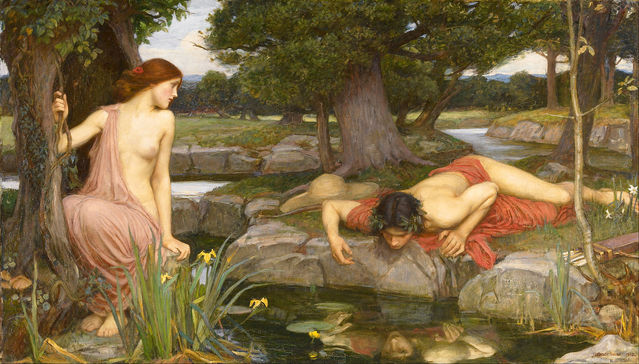Narcissism
When It Comes to Love, What Makes Narcissism So Attractive?
Looking in the mirror at our love of narcissists, part 2
Posted May 2, 2016

"Thus rejected she lies hid
in the deep woods, hiding her blushing face
with the green leaves; and ever after lives
concealed in lonely caverns in the hills.
But her great love increases with neglect;
her miserable body wastes away,
wakeful with sorrows; leanness shrivels up
her skin, and all her lovely features melt,
as if dissolved upon the wafting winds –
nothing remains except her bones and voice –
her voice continues, in the wilderness;
her bones have turned to stone."
— Metomorphoses, Ovid (8 A.D.)
In Part 1 of “Looking in the Mirror at our Love of Narcissists,” we discussed how the term “narcissist” is a clinically meaningless term and why we should instead stick to talking about “narcissism” as a continuous psychological trait or about “narcissistic personality disorder” as a psychiatric syndrome. Now that we have that understanding out of the way, let’s take a closer look at why we’re attracted to people with narcissistic traits.
The attraction to narcissism is easy enough to understand. As was discussed in Part 1, it’s healthy to have a certain amount of narcissism – the key is how to maintain (or find somebody with) just the right amount. Without a sufficient dose of self-love, a person can struggle with self-doubt, anxiety, lack of confidence, and low self-esteem. But with too much self-regard, one can lose focus on the healthy reward of caring about other people, causing problems in interpersonal relationships and our capacity for reciprocal love.
The thing is, narcissism is a complicated construct that includes aspects that can be alternatively adaptive (such as self-sufficiency, individualism, self-regard, confidence, a desire to lead, and ambition) and potentially destructive (such as arrogance, entitlement, vanity, lack of empathy, and a tendency towards interpersonal exploitation and manipulation), with these facets often co-existing in the same person.
When it comes to mate selection, the more adaptive aspects of narcissism are often seen as desirable characteristics. Think about searching for potential romantic partners online or going on a date. Who’s the better catch when it comes to cultural standards of attractiveness in men? One who can take the lead in suggesting a destination for a first date or one that sits back and defers? A man who can carry a conversation and tell a good joke or one that seems nervous and shy? One who takes care of himself by dressing well and exercising regularly or someone with a spindly frame whose clothes look like they could use a wash and an iron? A man who calls you back to suggest a second date with just the right amount of confident interest or the one who calls back too soon and too often?
Lest you dismiss these stereotyped comparisons as some kind of sexist ridiculousness, let’s acknowledge that everyone has their own individual standards for what they find attractive in a potential romantic partner and that we need not be slaves to cultural standards. But the point is that some of these aspects of narcissism may be favored in mate selection from an evolutionary perspective. And to make matters worse, seeking someone with healthy aspects of narcissism makes it more likely to find a mate with more problematic aspects as well.
For example, women often say they want someone who’s “confident, not cocky,” but finding just the right amount of narcissism isn’t always easy or even possible. Erring on the side of choosing someone with more confidence increases the risk of finding someone prone to cockiness, just as preferring someone who goes the gym regularly sporting six-pack abs ups the odds of finding someone who’s vain and excessively self-absorbed. The preference for the person who waits a week to call back after the first date makes us more likely to get together with someone who later doesn’t call back at all.
In Ovid’s Metomorphosis (see the quotation above and the entire poem here), the nymph Echo falls head over heels for Narcissus, a man of “unequaled beauty.” At their first meeting, Narcissus harshly spurns her advances, leading Echo to flee into solitude and wither away. And yet, “her great love increases with neglect,” suggesting that even pathological narcissism can be a powerful draw.
Turning from armchair speculation to actual experimentation, a 2010 paper by psychologists Nicholas Holtzman and Michael Strube analyzed the results of 18 studies investigating an association between narcissism and attractiveness and found that the two are indeed correlated.1 Although many of the studies measured used the Narcissistic Personality Inventory (NPI) that captures both healthy and dysfunctional aspects of narcissism (see my previous blogpost for a more extended discussion of this scale), nearly half employed scales that more specifically measured pathological narcissism. The authors speculated that the attractiveness of narcissism might have evolved along with short-term mating, that is, having brief sexual relationships.
A 2015 study from the UK that reported the results of a questionnaire given to single women aged 18-28 seems to support the idea that narcissism might have evolved as an advantage in short-term mating, with its finding that women who had more than 21 previous sexual partners were significantly more attracted to male narcissism than those who’d had less than 5 previous partners.2 But surprisingly, it also found that male narcissism was more attractive to women who desired marriage (i.e. long-term mating) than those who didn’t. This study used an adapted version of the NPI to measure of narcissism, raising the possibility that narcissism was conflated with self-esteem, but women desiring marriage were not only more likely than those who didn’t to agree with the statement, “I am drawn to a man who displays authority,” but also the statement, “A man who uses manipulation to influence his success at work is attractive.”
This finding suggests that we find narcissism attractive even in its darker shades because of its association with social success, where evolutionarily speaking, success is equated with “survival of the fittest.” In the animal kingdom, the dominant male in a pride of lions fights his way to the top and is the first in line to feast on a group kill at the expense of weaker members who risk starvation when resources are low. Female lions don’t typically pair with those weaker males, they seek to mate with the dominant male in order to maximize the survival of their offspring. So it may be with people, where success can be associated not only with confidence, but dominance and a proclivity for interpersonal exploitation as well.
This appeal of the darker side of narcissism appears to extend beyond the world of human romance and mating into the process of choosing our social leaders. A 2013 study claimed that the 42 US presidents through George W. Bush had “elevated levels of grandiose narcissism compared to the general population” and that this narcissism was associated with both presidential success as well as “indicators of negative presidential performance, especially in the ethical domain.”3 The authors noted that this finding illustrates the “bright side/dark side” of leadership. Narcissism, as we have discussed, includes this same duality.
Of course, we anticipate that by affiliating with someone with narcissistic traits, we might be able to share in the success of that narcissism, not always thinking that we might become its victim. Given the dual nature of narcissism, it’s unavoidable that sometimes we do.
In long-term mate selection, we often fall into the trap of searching for perfection, which ultimately reflects our own narcissistic needs. It would seem that a better strategy might be to realize that the search for perfection is doomed to fail and to instead try to find someone who will be compatible in the long run, based on both good qualities and the quirks and flaws that make us human.
But while that might sound good, it can be easier said than done. These days, it might be hard to avoid falling for someone with too much narcissism because narcissism is all around us and growing still. In the third and final installment of “Looking in the Mirror at Our Love of Narcissists,” we’ll turn from evolution to culture in order to examine whether there's a “Narcissism Epidemic” in the US and what, if anything, we might be able to do it.
Dr. Joe Pierre and Psych Unseen can be followed on Twitter at https://twitter.com/psychunseen. To check out some of my fiction, click here to read the short story "Thermidor," published in Westwind earlier this year.
References
1. Holtzman NS, Strube MJ. Narcissism and attractiveness. Journal of Research in Personality 2010; 133-136.
2. Haslam C, Montrose VT. Should have known better: The impact of mating experience and the desire for marriage upon attraction to the narcissistic personality. Personality and Individual Differences 2015; 188-192.
3. Watts AL, Lilienfield SO, Smith SF, et al. The double-edged sword of grandiose narcissism: Implications for successful and unsuccessful leadership among US presidents. Psychological Science 2013; 24:2379-2389.




